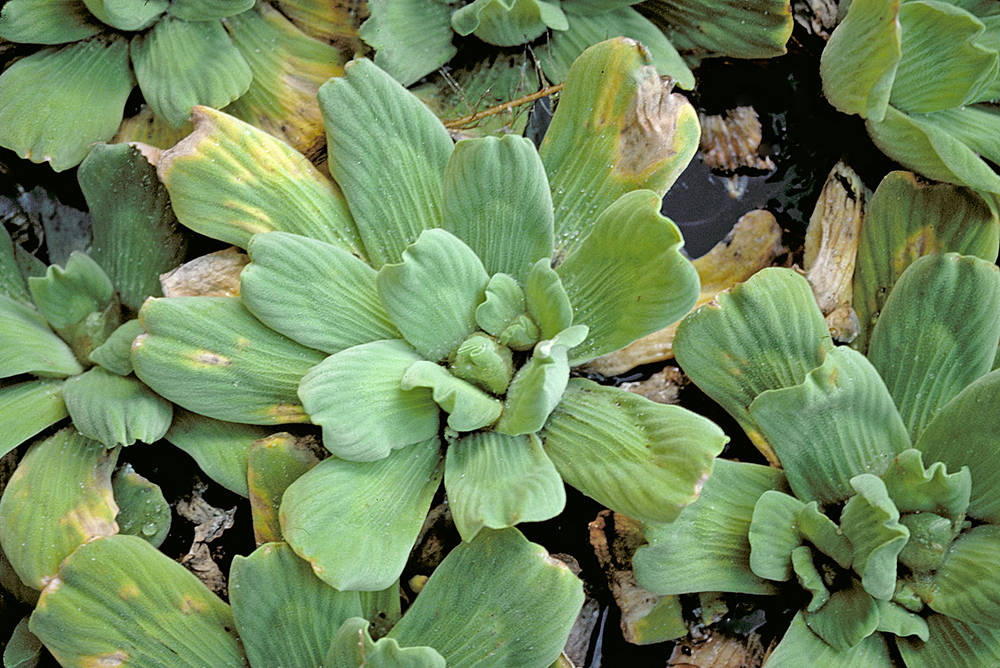
[This taxon does not have a floristic treatment in Flora of Oregon.]
as described under Pistia stratiotes
Roots to 50 cm, with short branches. Leaves light green to grayish green, 2--15(--20) cm, spongy, pubescence dense, white; major veins 5--13(--15), nearly parallel, abaxially prominent. Inflorescences: spathe white to pale green, convolute basally, slightly constricted above middle, spreading apically, pwhite to pale green, pubescent outside, glabrous inside; spadix adnate to spathe more than 1/2 its length, shorter than spathe; axis naked at base of staminate part and sometimes extending beyond staminate flowers. Flowers: staminate flowers (2--)6--8, in single whorl around central stalk, stamens 2, connate; pistillate flower solitary; ovariesy 1-locular, 4--5 mm; ovules 4--15(--20), orthotropous; styles ca. 3 mm; stigmas obtuse, with small hairs. ; staminate flowers (2--)6--8, in single whorl around central stalk; stamens 2, connate. Fruits with thin pericarp. Seeds light brown, cylindric, 2 ´ 1 mm. 2n = 28 (India, Borneo).Flowering mainly late summer--early winter (although; plants have been collected in flower in almost all months). Slow-moving streams, canals, drainage ditches, ponds, lakes, and springs; 0--10 m; Fla., La., Tex.; Mexico; West Indies; Central America; South America; Asia; Africa; Pacific Islands; Australia.Pistia stratiotes has been collected north and west of its U.S. range in Arizona, California, Georgia, Missouri, New Jersey, Ohio, and South Carolina. These are probably populations that do not persist. Although P. stratiotes is often reported as occurring from Florida to Texas, I saw no verifying herbarium specimens from Alabama or Mississippi, nor were any populations located during my fieldwork in those states.Other References Arditti, J. and E. Rodriguez. 1982. Dieffenbachia: Uses, abuses and toxic constituents: A review. J. Ethnopharmacol. 5: 293--302. Barrett, O. W. and O. F. Cook. 1910. Promising root crops for the South. U.S.D.A. Bur. Pl. Industr. Bull. 164: 1--43. Bartram, W. 1791. Travels through North and South Carolina, Georgia, East and West Florida, the Cherokee Country, the Extensive Territories of the Muscogulges, or Creek Confederacy, and the Country of the Chactaws.... Philadelphia. Bierzychudek, P. 1982. The demography of Jack-in-the-pulpit, a forest perennial that changes sex. Ecol. Monogr. 52: 335--351. Blackwell, W. H. and K. P. Blackwell. 1974. The taxonomy of Peltandra (Araceae). J. Elisha Mitchell Sci. Soc. 90: 137--140. Blair, A. 1975. Karyotypes of five plant species with disjunct distributions in Virginia and the Carolinas. Amer. J. Bot. 62: 833--837. Boivin, B. 1967--1979. Flora of the prairie provinces. Part I (--IV). Phytologia 15--18, 22--23, 42--43; passim. [Reprinted as Provancheria 2--5 with auxiliary pagination.] Bowden, W. M. 1940. Diploidy, polyploidy, and winter hardiness relationships in the flowering plants. Amer. J. Bot. 27: 357--370. Bruner, M. C. 1982. Water-lettuce, Pistia stratiotes L. Aquatics 4(3): 4--5. Camazine, S. and K. J. Niklas. 1984. Aerobiology of Symplocarpus foetidus: Interactions between spathe and spadix. Amer. J. Bot. 71: 843--850. Case, F. W. , Jr. 1992. Plants for the bog garden. Bull. of the Amer. Rock Garden Soc. 50: 129--144. Clay, K. 1993. Size-dependent gender change in green dragon (Arisaema dracontium; Araceae). Amer. J. Bot. 80: 769--777. Coates, D. J., D. E. Yen, and P. M. Gaffey. 1988. Chromosome variation in taro, Colocasia esculenta: Implications for origin in the Pacific. Cytologia 53: 551--560. Croat, T. B. 1994. The use of the New World Araceae as drug plants. J. Jap. Bot. 69: 185--203. Dorn, R. D. 1977. Manual of the Vascular Plants of Wyoming. 2 vols. New York. Dray, F. A. Jr. and T. D. Center. 1989. Seed production by Pistia stratiotes L. (water lettuce) in the United States. Aquatic Bot. 33: 155--160. Duncan, W. H. and J. T. Kartesz. 1981. Vascular Flora of Georgia: An Annotated Checklist. Athens, Ga. Eastwood, A. 1900. Some plants of Mendocino County new to the flora of California. Zoëe 5: 58--60. Fernald, M. L., and A. C. Kinsey, and (revised by R. C. Rollins). 1958. Edible Wild Plants of Eastern North America, revised ed. New York. Greenwell, A. B. 1947. Taro---with special re